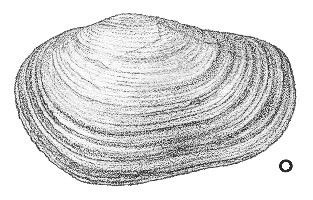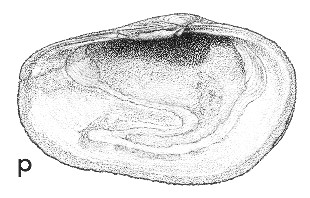
Revised descriptions of New Zealand Cenozoic Mollusca from Beu and Maxwell (1990)

 | Revised descriptions of New Zealand Cenozoic Mollusca from Beu and Maxwell (1990) | 
|
  (Pl. 41o): paratype of Panopea wanganuica (figured by Powell 1950, p. 79, fig. 8), Nukumaru Brown Sand, Nukumaru Beach, west of Wanganui, Nukumaruan (TM4775, GNS) |
  (Pl. 41p): paratype of Panopea wanganuica (figured by Powell 1950, p. 79, fig. 8), Nukumaru Brown Sand, Nukumaru Beach, west of Wanganui, Nukumaruan (TM4775, GNS) |
Beu & Maxwell (1990): Chapter 15; p. 317; pl. 41 o,p.
Synonymy: Panopea smithae Powell 1950, p. 78, pl. 7, fig. 5; Panopea wanganuica Powell 1950, p. 80, pl. 7, fig. 6.
Classification: Hiatellidae
Description: Moderately large for genus (90-110 mm long), long and relatively low, with narrow anterior gape and very wide posterior gape; dorsal and ventral margins almost straight, parallel or converging slightly towards posterior. Sculpture of prominent, irregular, commarginal folds. Margins smooth. Hinge without teeth, but with prominent narrow resilifer behind the umbo, and (in well preserved shells) long, thin, curved apophysis protruding at right angles to hinge. Anterior adductor scar tall and narrow, posterior smaller and more equidimensional; pallial line wide and obvious, with very deep sinus extending forward to below umbo.
Comparison: Panopea zelandica (Kapitean?-Recent) has a much shallower pallial sinus, less than half the length of that of P. smithae, and most specimens are taller and more squarely truncated at the posterior end than in P. smithae. Powell (1950, pp. 76-80) distinguished two deep-sinused species, the fossil P. wanganuica and the living P. smithae, differing in shell shape, but Panopea species are notoriously variable in shape, depending on the substrate they burrow in, and the great variation of both the fossil and living shells makes two species impossible to separate. Beu (2006, p. 292) pointed out that both Recent and fossil specimens are more variable in shape than Powell (1950) realised, and the same shapes can be found in all populations; he synonymised P. wangnauica with P. smithae. P. zelandica is a shallow-water species, burrowing 0.7 m or more into sand in large bays and on the inner shelf, in water up to about 30 m deep, whereas P. smithae lives in a greater variety of sediments (coarse shell gravel to muddy sand) and in a greater depth range (e.g., in Wellington Harbour, but in deeper water than P. zelandica, to outer shelf). Both P. zelandica and P. smithae are commonly found fossil in life position, with conjoined valves normal to bedding. P. zelandica is the more common in shallow facies, and P. smithae is the more common in deeper facies. Typical large, cylindrical specimens of P. smithae occurs fossil in sand below the Cascade Moraine on the north side of Cascade Point, south of Jackson Bay (Castlecliffian). The Miocene P. orbita is more narrowly cylindrical, with more prominent commarginal folds, but age ranges are unclear.
Distribution: Waipipian(?)-Recent. Recent, trawled off eastern Otago, between the Nuggets and the mouth of the Waitaki River, in c. 140 m (type of P. smithae); Castlecliff, Wanganui (bivalve shellbed member of Kupe Formation), Castlecliffian (type of P. wanganuica); widespread in New Zealand in rocks of Pliocene and Pleistocene age. As P. smithae was named while Fleming's (1953) Wanganui bulletin was in preparation, Fleming did not distinguish P. smithae from P. zelandica, and their stratigraphic distributions at Wanganui have not been resolved. However, most records we have examined are of P. smithae.
Cite this publication as: "A.G. Beu and J.I. Raine (2009). Revised
descriptions of New Zealand Cenozoic Mollusca from Beu and Maxwell (1990). GNS
Science miscellaneous series no. 27."
© GNS Science, 2009
ISBN
978-0-478-19705-1
ISSN 1177-2441
(Included with a PDF facsimile file
copy of New Zealand Geological Survey Paleontological Bulletin 58 in CD version
from: Publications Officer, GNS Science, P.O. Box 30368 Lower Hutt, New
Zealand)